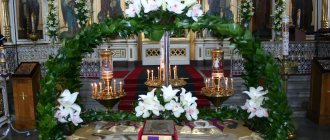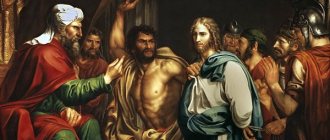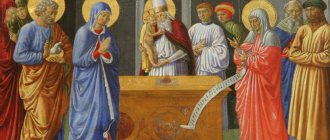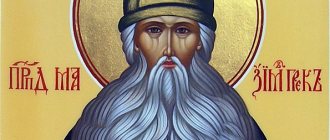The Feast of the Epiphany (another name is Holy Epiphany ) is the twelfth Orthodox holiday, which is celebrated annually on January 19 (January 6, old style). The Feast of the Baptism of the Lord was established in remembrance of an event in gospel history - the Baptism of Jesus Christ in the Jordan by John the Baptist. The Baptism of the Lord is preceded by several days of pre-celebration, and after it - a post-celebration. Everyone knows that on this day and the day before, on Christmas Eve, there is a blessing of water . Usually on these days even those who do not usually attend services come to the temple - “to get water.”
Epiphany. Holiday event
We learn about the events of the Baptism of the Lord from the Gospels. We know almost nothing about the life of Jesus Christ before the age of 30. The beginning of His public ministry was preceded by the sermon of the prophet John, therefore called the Forerunner. Even before his birth, the great Prophet and Preacher John greeted the Lord: “The baby leaped in her womb,” says Evangelist Luke about the meeting of the Mother of God with her relative Elizabeth after the Annunciation.
John the Baptist was six months older than Jesus Christ. Tradition says that during the massacre of the infants by Herod, Elizabeth hid with her son John in the desert, and his father, the high priest Zechariah, was killed in the temple because he did not hand over his son to Herod’s soldiers. In memory of this, in every Orthodox church, a red carpet is laid out from the Altar, through the Royal Doors to the pulpit and down the steps, as a symbol of the shed blood of the righteous.
Library of Russian Faith
Remembrance of the Holy Epiphany of our Lord and God Jesus Christ
Great Menaion of Cheti. Part 1 →
Great Menaion of Cheti. Part 2→
Read online in original
The age of Christ's baptism is the age of majority
We read in the Gospel about the age at which Jesus was baptized:
Luke 3:23
When Jesus began His ministry, he was about thirty years old.
The Lord was baptized at the same age as the Israelite became an adult. This tradition was followed for some time by the Eastern Church. When the majority of the population of Christian states became Christians, they began to baptize infants more often, because all relatives had already been baptized.
History of the celebration of Epiphany
The Feast of the Epiphany has been known since the 2nd-3rd centuries. Then the Nativity of Christ and His Baptism . Since the 4th century, the Nativity of Christ has been celebrated on December 25, and the Epiphany of the Lord on January 6. The second name of the holiday, Epiphany, indicates the appearance of the Trinity. When the Lord Jesus Christ emerged from the waters of the Jordan, all those present heard the voice of God the Father and saw the Holy Spirit descend in the form of a dove. The Feast of the Epiphany, like the Nativity of Christ, is preceded by Christmas Eve - a day of strict fasting. If Christmas Eve coincides with Sunday, then the Royal Hours are moved to the previous Friday, and the Liturgy of St. Basil the Great is celebrated on the day of the holiday itself.
John the Baptist (i.e., the one going ahead) preached in the Judean desert, preparing people to accept the teachings of the Lord Jesus Christ. “Repent,” he said to the people who came, “the Kingdom of Heaven is approaching!” Many people came to listen to his preaching, repented of their sins and were baptized in the waters of the Jordan. Jesus Christ came from Galilee to John, asking for baptism. John answered him: “I should be baptized by You, but You demand baptism from me!” But the Lord commanded the Forerunner to perform baptism. When Jesus Christ came out of the water, the heavens opened, and the Holy Spirit descended in the form of a dove, and the voice of God the Father was heard:
This is My beloved Son, in whom I am well pleased (Matthew 3:17).
history of the holiday
The event was established in memory of the baptism of Jesus Christ in the Jordan River by John the Baptist. During the life of the Savior, only adults who were able to experience religion and faith in God were baptized (Jesus was baptized at the age of 30).
The holiday received the name “Epiphany” because the Holy Trinity appeared during the sacrament of baptism of the Savior. The Holy Spirit descended on Jesus Christ in the form of a white dove and the heavenly voice of the Father, which proclaimed him the Son of God.
Epiphany. Festive Worship
Festive services for Epiphany continue for several days: the day before - eve (“Christmas Eve”), then the feast of Epiphany itself, on the third day a service is performed at the Cathedral of John the Baptist. The texts of the services contain not only a story about the events of the holiday, but also an explanation of its meaning, as well as a recollection of all the prototypes, predictions and prophecies. Thus, the prototype of the Baptism of the Lord in the Jordan was the division of river waters, which was performed by the prophet Elisha with the mantle (clothing) of the prophet Elijah. Isaiah prophesied about Baptism: “Wash yourselves, and you will be clean” (Is. 1:16-20). The Psalms of King David, which contain prophecies about the Baptism of the Lord, are also read during the festive service.
In ancient times, on the feast of the Epiphany, the baptism of catechumens was performed, who had been preparing for a long time to receive the Sacrament. Many moments of the service are reminiscent of this custom: a larger than usual number of proverbs, excerpts from the prophetic and narrative books of the Old Testament, during the reading of which the Sacrament of baptism was performed, the singing of “Be baptized into Christ...” and even the very consecration of water.
The service for the feast of Epiphany is performed especially solemnly; in ancient times it lasted all night. The All-Night Vigil begins with the Great Vespers, at which the song of the prophet Isaiah “God is with us!” is sung. This is followed by litiya - a series of stichera that talk about the events that took place in the Jordan 2000 years ago. Those praying become witnesses of the Baptism of the Lord.
Here John the Baptist, knowing Whom he was to baptize, did not dare to approach Him: “How can hay touch fire?” Seeing the Lord, the Forerunner “rejoices” and trembles his hand. shows є3го2, и3 here people, this and 3save ї}лz, freed us t and3stlenіz” .
Another stichera tells how the hand of the Baptist trembled and the river waters flowed back - they did not dare to touch the Lord : “The hand of the Baptist trembles, when the most holy one touched the top. return the river to sleep, don’t dare come closer to you.”
John the Baptist fulfills the command of God and baptizes the One whose messenger, predecessor, Forerunner he is. “ E$he t dv7y lntsa, vi1dz and4zhe t unfruitful light. in їwrdan it’s simpler kRshcheniz. With horror and3 joy you speak to8 him2, you2 mz w©ti2 in the divine direction of your1m .”
(Translation: The Lamp, born from a barren mother, seeing the Sun, born from the Virgin, the Lord asking for baptism in the Jordan, with horror and joy says to him: “You sanctify me, Master, by Your appearance”).
The canons for the holiday were written by hymnographers who lived in the 8th century - the Venerable Cosmas of Maium and John of Damascus. The texts of the canons are quite difficult to understand; they explain the spiritual meaning of the holiday. The Apostle (Tit. II, 11-14; III, 4-7) says that with the coming of the Savior the grace of salvation was brought to earth. The Gospel (Matthew III, 13-17) tells of the baptism of the Savior by John the Baptist.
Library of the Russian Faith Canon of the Epiphany →
Read online
On the feast of the Epiphany, two water blessings are performed. One is performed on the eve of the holiday in remembrance of the Baptism of the Lord, and the other on the holiday itself. Usually the consecration of water takes place in the center of the temple, but in some parishes, mainly rural, the custom of going to the nearest body of water has been preserved, where an ice hole has been prepared in advance - “Jordan”. The custom of consecrating water on the day of Epiphany was known already in the 3rd century. The blessing of water on the eve of the feast of Epiphany is performed as follows: the clergy come out of the altar, the primate holds the Holy Cross on his head while presenting lamps. At this time, the singers sing: “ The voice of the Lord cries on the waters, saying, ” and other troparia. Then three proverbs are read, the Apostle and the Gospel, telling about the baptism of Jesus Christ. After the Gospel, the deacon pronounces a litany; then the priest reads the water-blessing prayer, in which he asks the Lord to grant sanctification, health, cleansing and blessing to all who receive communion and anoint with holy water. After the prayer, the priest immerses the Cross in water three times while singing the troparion: “ They are baptized in the Jordan, O Lord .” Then the priest sprinkles blessed water on the temple and all those present. On the holiday itself, the blessing of water is preceded by the singing of the canon-prayer for the holiday, according to the 6th song of which the blessing of water is performed according to the same rite.
Troparion for the holiday. Church Slavonic text:
In the Jewish world, we are baptizing our children, our spiritual worship, our parents’ voice of your testimony, our beloved’s witness, and our 3rd vision of the dove, and your words are affirmed. kvleisz xrte b9e, i3 mjr enlightenment, glory to you.
Russian text:
Lord, when You were baptized in the Jordan, the worship of the Holy Trinity appeared: for the voice of the Father testified of You, calling You the beloved Son, and the Spirit, in the form of a dove, confirmed the truth of the words (of the Father): Christ God, who appeared and enlightened the world, glory to You.
Kontakion for the holiday. Church Slavonic text:
Appeared today in the universe, and 3 the light of your city and the signs are upon us, and in the 8 minds of the singing tS, when we come, and 3 kvi1sz the light is untouchable.
Russian text:
Now You, Lord, have appeared to the universe, and the light has been revealed to us, who intelligently sing to You: “Unapproachable Light, You have come and appeared to us.”
Signs and beliefs
- If the weather is sunny and frosty on January 19, then the summer will be hot and fruitful.
- A couple who gets married on Epiphany will live a long and happy life together.
- On Epiphany night the heavens open to the requests of people. If you pray for something, your request will definitely come true.
- Anyone who is baptized on the day of Holy Epiphany will live a long and happy life.
- If a young girl goes out on Epiphany morning and meets a young guy, then she will get married this year. If the first person she meets is an elderly man, then she will be lonely all year.
January 19 is one of the main holidays of the Orthodox Church. On the night of Epiphany, people go to churches for all-night vigils, which end with the morning divine liturgy and the blessing of water. Epiphany water has miraculous powers. She is able to heal and protect from evil spirits.
Holy water, great Agiasma
According to the Church Charter, the consecration of water occurs five times a year: on the eve and on the day of the feast of Epiphany, on the feast of Mid-Pentecost (between Easter and Trinity), on the feast of the origin of the Venerable Cross (“the first Savior”, August 1/14) and on the patronal, temple holiday. Of course, the blessing of water can be performed more often, as needed, during services. Epiphany holy water is considered “annual”.
The water is blessed by Metropolitan Alimpiy (Gusev)
The water consecrated on the eve of Epiphany is called Great water; it can be sprinkled in all, even unclean, places of the house and household. It is allowed to drink even after eating food. But the Charter commands its use for a limited time - three hours after consecration or, depending on the distance of the journey, one hour after arrival. After this time, using the Great Water for any needs is strictly prohibited. Moreover, if it accidentally spills, this place should be burned out or cut down so as not to trample it underfoot (as is the case if Communion is spilled). Great water has long been given communion to those who are excommunicated from the communion of the Body and Blood of Christ due to any sins. You can read more about this in Gleb Chistyakov’s article “Great Water”.
Water blessed on the day of the Epiphany is reverently kept by Christians. It is drunk only on an empty stomach, after performing morning prayers.
There is a misconception that on the feast of the Epiphany, all water in rivers, lakes and even in water taps becomes holy. This is wrong! Holy water becomes holy only after the completion of the church rite, the actions and prayers of the priest determined by the Charter.
What not to do at Epiphany
On January 19, it is prohibited to store holy water in large quantities. On the holy day, you cannot quarrel, swear, lie, complain, gossip, or entertain bad thoughts. It is undesirable to engage in heavy physical labor, clean the house, wash, or cut with scissors. It is not recommended to get a haircut, manicure or pedicure, so as not to bring bad events into your destiny. You should not sew or knit, so as not to confuse your fate. It is forbidden to borrow money, otherwise the whole year will pass in debt. On this day, it is advisable not to overeat so that your thoughts remain clear. On January 19, after the end of Epiphany Eve, it is forbidden to guess.
Celebration of Epiphany. Folk traditions and customs
The festive service and blessing of water on the eve of Epiphany in Rus' were performed especially solemnly. It was a national holiday. Everyone walked in procession to the “Jordan”, arranged on rivers and lakes. The service was especially solemnly celebrated in the Assumption Cathedral of the Moscow Kremlin, where the Tsar and the Patriarch prayed. The Blessing of Water on Christmas Eve took place in the cathedral, and on the feast of Epiphany itself there was a religious procession with the singing of the festive canon to the Moscow River, where an ice hole in the shape of a cross was prepared. The blessing of water was performed very solemnly, with a large crowd of people. This ceremony had not only church, but also state significance.
B. Kustodiev. Winter. Epiphany blessing of water
The peasants spent the entire day before Epiphany in strict fasting (even children and teenagers tried not to eat “to the star”), and during Vespers, small village churches usually could not accommodate the entire mass of worshipers. The crowd was especially great during the blessing of water, since the peasants maintained the belief that the earlier they draw blessed water, the more holy it is. Upon returning from the blessing of water, each householder with his entire family reverently drank a few sips from the brought vessel, and then took the sacred willow from behind the icon and sprinkled holy water on the entire house, outbuildings and all property, in full confidence that this protects not only from troubles and misfortunes, but also from the evil eye. In some provinces it was considered a rule to pour holy water into wells so that unclean spirits would not get in there and pollute the water. At the same time, they strictly observed that no one took water from the well until the morning of January 6, that is, before the consecration of the water after mass.
After all these rituals were completed, holy water was usually placed next to the images, since the peasants not only believed in the healing power of this water, but were just as firmly convinced that it could not spoil, and that if you freeze the Epiphany water in any vessel, then on the ice you will get a clear image of a cross. Approximately the same sacred meaning was attributed by the peasants not only to water blessed in the church, but also to simply river water, which receives special power on the eve of Epiphany. According to popular belief, on the night of January 5-6, Jesus Christ himself bathes in the river, so in all rivers and lakes the water “sways,” and to notice this wonderful phenomenon, you only need to come to the river at midnight and wait at the ice hole, until “the wave passes” (a sign that Christ was immersed in water). This widespread belief created a custom among the peasantry, due to which it was considered a great sin to wash clothes in the river where the baptismal blessing of water took place before the end of the week.
On the day of Epiphany, as soon as the bell struck for matins, movement began in the villages: people hurried to light bundles of straw in front of the huts (so that Jesus Christ, who was baptized in the Jordan, could warm himself by the fire), and special amateur craftsmen, asking for a blessing from the priest , were busy on the river, organizing a “erdan”. With extraordinary diligence, they carved a cross, candlesticks, a ladder, a dove, a semicircular radiance, and around all this a grooved depression for the flow of water into the “bowl” in the ice. During the service, a clergyman stood near the bowl, and while reading the litanies, a special knowledgeable person punched the bottom of this bowl with a strong and dexterous blow, and water burst out of the river like a fountain and quickly filled the radiance (deepening), after which a long eight-pointed cross seemed to float above the water and matte silver glittered on its surface. A mass of people usually flocked to this celebration, both old and young - everyone was in a hurry to “Erdan”, so that the thick ice, one and a half arshins, cracked and bent under the weight of the worshipers. The parishioners were attracted not only by the beauty of the spectacle and the solemnity of the service, but also by the pious desire to pray, drink the blessed water and wash their faces with it. There were daredevils who even swam in the ice hole, remembering that a person cannot catch a cold in the blessed water.
Unfortunately, in addition to pious traditions, in ancient times and today there are many superstitions and almost pagan customs. Among such customs, one can, for example, point out the “blessing of livestock” by the peasants themselves, a special type of fortune-telling and bride viewings dedicated to this day.
There are also people who regard holy water as a talisman. Many come to the temple not for prayer, but “for water.” It often happens that the service has not yet ended, but people are already crowding and making noise near the font with holy water. There are often grievances and quarrels.
Many people believe that it is necessary to swim in an ice hole at Epiphany. You can't do without alcoholic drinks here either. This far from Orthodox custom is becoming increasingly widespread. Fr. talks in detail about how to properly treat holy water and whether it is necessary to swim in an ice hole. John Kurbatsky in the article “Epiphany bathing does not wash away sins!”
Since ancient times, there has also been a pious custom of calling a priest into one’s home with holy Epiphany water on the days after the feast of Epiphany. Currently, this custom, unfortunately, is almost lost.
Bathing for Epiphany
The Orthodox Church opposed the celebration of Christmastide, during which people sinned by turning to evil spirits in rituals of disguise and fortune-telling, which had their roots in pagan times. The clergy compromised by inventing the ritual of bathing at Epiphany. To do this, an ice hole is made in natural reservoirs - a Jordan, which the priest sanctifies by lowering a cross into it. It is believed that anyone who dips into Jordan three times will be cleansed of sins. Bathing at Epiphany is gaining popularity not for the purpose of spiritual cleansing, but as a hardening process.
Bathing for Epiphany
Epiphany. Icons
Images of the Epiphany appeared already in the first centuries of Christianity. One of the oldest images of Baptism was preserved in the early Christian catacombs of Rome, where Christ, baptized by the Forerunner, was depicted as a young man.
Epiphany. Arian Baptistery in Ravenna. 493-526 Dome mosaic
In the future, in accordance with church tradition, the image of the Baptism of the Savior as an adult will become widespread.
Epiphany. Mosaic of the Cathedral of San Marco. XIII century Venice, Italy. Fragment
Epiphany. Mystra. Church of Our Lady Periveleptus, XIV century.
Three angels were often depicted, bending towards Christ and, like receivers from the font, holding the veils on their hands.
Baptism. Double-sided tablet icon. End of the 15th - beginning of the 16th centuries. Novgorod State Historical, Architectural and Art Museum-Reserve, Novgorod
Epiphany. Double-sided tablet icon. 2nd quarter of the 15th century. Sergiev Posad State Historical and Art Museum-Reserve
Epiphany. Icon from the festive rite of the Assumption Cathedral in Vladimir. 1408 State Russian Museum, St. Petersburg
Epiphany. From the festive ceremony. Vladimir-Suzdal Historical, Artistic and Architectural Museum-Reserve, Vladimir. Second half of the 15th century.
Content:
- Epiphany of the Lord: history and traditions of the holiday
- Properties of holy water. Where can I get it?
- Why is it always frosty at Epiphany?
- Epiphany swimming or diving into an ice hole How did the tradition of diving into an ice hole in winter come about?
- How does immersion in ice water affect the body: a medical point of view
- How do I know if I should dive into an ice hole? Pros, cons and risks
- Is it possible to bathe children in the ice hole? Pediatricians' opinion
- How to dive into an ice hole correctly so as not to get sick?
Fortune telling
Fortune telling at Epiphany in the old days was perhaps the most popular entertainment. Although fortune telling is not a religious custom at all and has nothing to do with the feast of the Epiphany itself, but goes back to paganism, nevertheless young people still do it to this day.
They guessed on absolutely everything that came to hand - it could be objects and animals, sounds, shadows. Interpreting what a girl sees in water, a mirror, on a wall or in snow was an art. In an ordinary drop of wax at the bottom of a saucer, especially impressionable people could see the whole story of their life.
Addressed
There was fortune telling, which both boys and girls enjoyed doing. They asked the name of passers-by: for women - male, for men - female. It was believed that this would be the name of the future groom or bride.
Shoe by shoe
“Once on Epiphany Eve the girls were wondering: they took a shoe off their foot and threw it behind the gate.” Fortune telling with a shoe (shoe, felt boot) is the most common. It was believed that in which direction the toe of a shoe that fell to the ground points, the betrothed will take the bride there. The shoe must be removed from the left foot. If the shoe falls with its toe towards the house, marriage is not expected this year.
To bed
This is one of the most common fortune telling. The girl puts a comb under the pillow, saying: “Mummer, comb my head.” The one she sees in her dream will be her groom.
On wax
This is fortune telling for those who have a remarkable imagination. When the candle is lit, tilt it over a bowl of water and let a few wax drops fall into the water. If you get several small round shapes, this means money. And large figures can be interpreted as follows:
grapes mean love, friendship, luck, prosperity;
mushroom – vitality, perseverance, longevity;
bell - lead: straight - to the good, crooked or chipped - to the bad, several bells - alarm;
an apple is a symbol of life, wisdom, health. If it is too crooked, it means a temptation that is better not to succumb to.
But remember: during fortune telling, a person’s soul is in the hands of evil spirits, which is why fortune telling has always been condemned by the church. That is why in the old days those who fortune-told the next day, on Epiphany, always plunged into the ice hole, thus washing away their sins.











